Luftwaffe Steel Helmet M40
CATEGORY: Version
SKU: 22.GOR.01.02.01.004.000
Estimated market value:
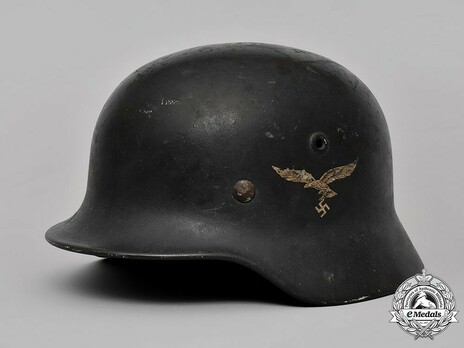
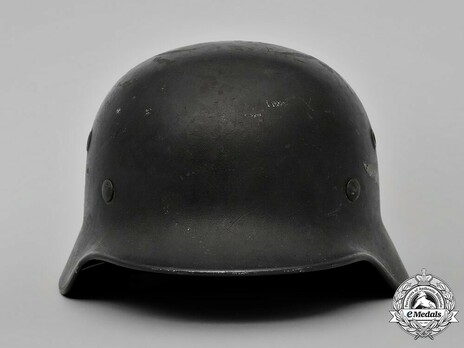
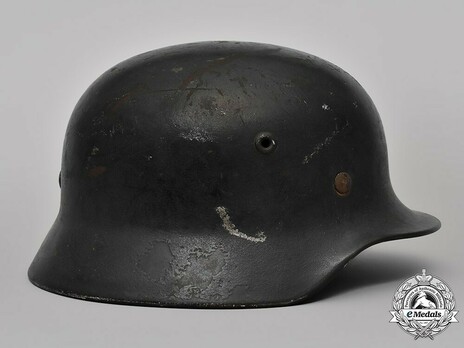
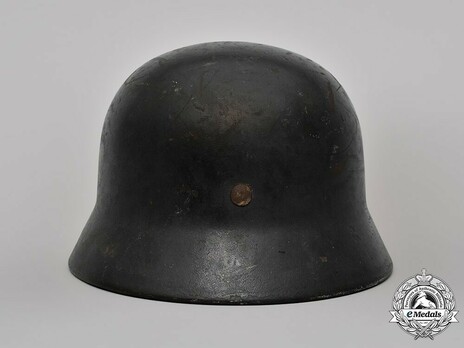
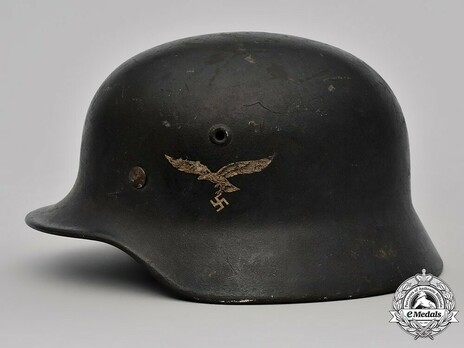
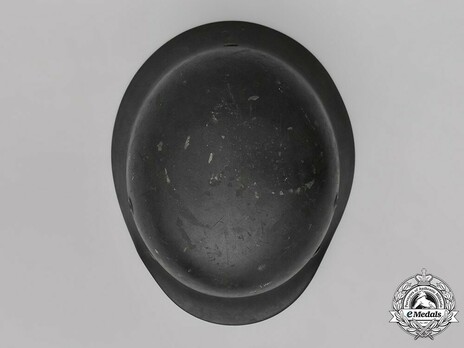
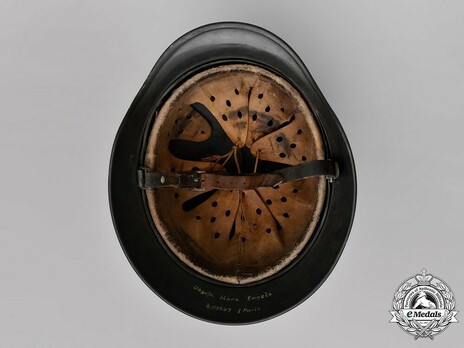

Estimated market value:
Constructed of molybdenum steel (magnetic); with its original green paint on the interior and exterior. It features stamped air vents and a smooth finished edge along the entire helmet, making this a signature M40 helmet. The interior has its original butterscotch-coloured leather liner, constructed of eight leather panels, each with five ventilation holes, and an additional hole at the top for the drawstring to be fed through. The drawstring itself is constructed of twisted/embroidered white string, and appears to be original to the helmet. The chin strap is constructed of leather that is stained/oiled to a rich black colour, with its original metal hardware, and is securely fastened to the metal frame within the helmet. The underside of the skirt on the reverse is stamped “DN101” and is marked “Obgefr. Hans Engels, 403997, I-Paris” in white period markings, and is stamped “Q64” for “Quist” and size “64”. On the left of the exterior is a Luftwaffe eagle decal. The helmet measures 226 mm (w) x 281 mm (h). The exterior of the helmet is well preserved, with only minor scrapes and paint transfer from storage. The interior is also well preserved, with light to moderate wear to the liner from use. he chin strap is also well preserved, without significant cracking in the leather. In near extremely fine condition, with only minor signs of wear.
The helmet of the German Wehrmacht became one of the most recognisable items of the German soldier in the Second World War, just like the “Pickelhaube”, the spiked helmet, had come to be a symbol associated with the German Imperial Army. However, where the spiked helmet fulfilled more of a ceremonial function, the steel helmet was intended as a practical item for the battlefield, designed to protect and shield its wearer from grenade splinters and other forms of shrapnel.
The basic materials of which the helmet was fashioned include steel, aluminum, and leather. On the inside there is a helmet liner, designed to absorb shock. Most helmets have two grommet ventilation holes. The chinstrap was usually dyed black.
The helmets came in five sizes. Their quality significantly worsened as time and the war progressed.
A black, white, and red shield was painted onto the right side. The shield was to be abolished in 1940. However, this was not always adhered to. Onto the left side of the helmet a Luftwaffe style eagle decal was painted, facing towards the front. There are two main patterns of this eagle. The first pattern is nicknamed the “droop tail” pattern. It fell out of use in 1940. It is characterized by a shorter wingspan compared to the second pattern, the eagle has an open beak, and is more “cartoonish” in appearance. The second pattern eagle is known as the “stylized” eagle. It first appeared in 1937. Compared to the first pattern, this eagle has a wider wingspan, a closed beak, and appears more graphically life-like. Eagles were gold-coloured for general ranks and silver-coloured for everybody else. The eagle decal was eliminated in 1943, but, again, this was not always adhered to. Due to the differing number of decals on the helmets, versions have been dubbed double decal, single decal, and no decal.
Luftwaffe helmets are blue-grey in colour. Pre-war helmets often have the wearer’s unit stamped or painted in the interior.
Several ways of camouflage were used. Depending on availability and terrain, these included painting the helmets, attaching wires, nets, or straps to hold foliage and branches, and some units were even given cloth camouflage liners, introduced in 1942, to wrap around the helmet. These however were only used on special occasions and only by frontline or elite troops. Camouflage liners show a pattern of shapes and colours on one side, including several straps for attaching foliage, whereas on the other side they are white for wear in winter, and miss any additional straps.
Apart from the camouflage liners camouflaging efforts were not applied by the producing companies, but only made in the field, either by individual soldiers or whole units. This practice started in 1940/41 in North Africa.
Camouflage helmets have been found with varying patterns, or single-coloured to blend in with more uniform terrain, like the sand-coloured helmets used in northern Africa, with actual sand mixed in with the paint, or the white-washed or painted helmets used during the winter, especially on the Eastern Front.
In the early 1930s soldiers could privately purchase lighter helmet versions, often made from plastic or aluminum. These were worn with the dress uniforms, for example during parades. They were mostly targeted at older or wounded veterans for whom the weight of a regular helmet would be difficult to wear.
As the manufacturing progressed from one model to the next, there was no official change in the name of the helmets. The terms “M(odel) 35” or “M(odel) 40” were attributed to the different varieties by collectors after the war and have no official character.
Helmets will vary in appearance due to production by different factories and subcontractors, and changes in specifications.
Inspired by the first modern steel helmets introduced by the French and the British, the first German steel helmet was developed and introduced in early 1916. It was slightly modified in 1918 in that the lugbolts on the neck guard were removed and replaced by a “D” type connection that was directly affixed to the liner band. A special version of the M18 helmet has a cut-out part of the rim around the ear. It was used by those soldiers that needed to use communication devices and relied on their ability to hear.
Minor modifications were made in 1923 with the introduction of provincial shield decals, and in 1931 with new chinstraps and a new liner system. On March 14, 1933 the provincial shields gave way to the national tricolour shield.
However, the M16 and M18 helmets proved to be ineffective to cope with the effects of new and improved ballistics. A new model, the M35 helmet, was designed. The steel was reinforced and the helmet was slightly smaller, but the design remained the same. It was introduced on June 25, 1935. However, production only began in late 1935, and the first time it was given out in mentionable quantities was in 1936.
Even after the development of the M35 Steel Helmet, the M16 helmet was still used by second line and training troops, and continued to be used well into the Second World War.
The Model 40 was introduced in 1940. It differs from the Model 35 in that the manufacturing process was simplified by way of a hot stamping technique. The ventilation holes were made in a different way, and the painting looks more grey and rough. Other than that, the two models are very similar.
The Model 42 was introduced on April 20, 1942. Production was made yet more economical, which resulted in a helmet looking even more crude in design and colour. The biggest difference was that the rim was left to be sharp now instead of the earlier practice of crimping it inwardly to make a round rim.

Comments
Sign in to comment and reply.


Scroll Top